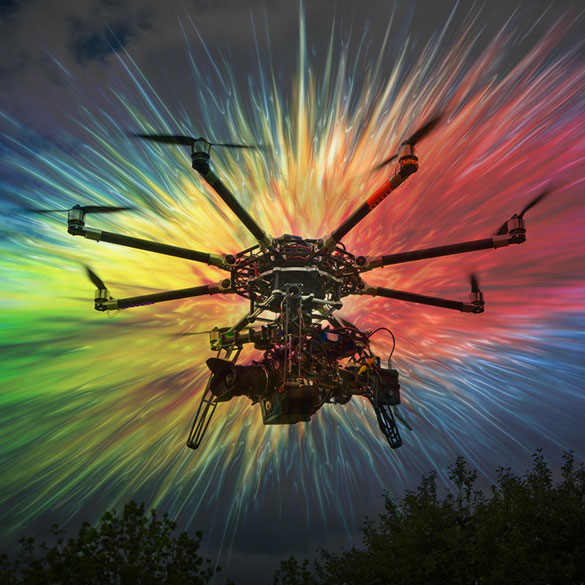“The privacy and dignity of our citizens [are] being whittled away by sometimes imperceptible steps. Taken individually, each step may be of little consequence. But when viewed as a whole, there begins to emerge a society quite unlike any we have seen–a society in which government may intrude into the secret regions of a [person’s] life.”—Justice William O. Douglas
Imagine a robot hovering overhead as you go about your day, driving to and from work, heading to the grocery store, or stopping by a friend’s house. The robot records your every movement with a surveillance camera and streams the information to a government command center. Whether you make a wrong move, or appear to be doing something suspicious, even if you don’t do anything suspicious, the information of your whereabouts, including what stores and offices you visit, what political rallies you attend, and what people you meet will be recorded, saved and easily accessed at a later date.
As I document in my book, A Government of Wolves: The Emerging American Police State, this scenario is inching ever closer to becoming our reality as corporations and government agencies alike prepare for their part in the coming drone invasion. The online retailer Amazon is designing its own pilotless delivery drones, octocopters, which would be used to deliver products under five pounds within a 10-mile range and with a 30 minute turnaround. The Domino’s pizza chain has also been looking to unmanned drones to give it an edge on its competitors. The “DomiCopter” is being developed to deliver two Domino’s pizzas in the company’s Heatwave bags. Not to be outdone, there’s also a TacoCopter drone—for delivering tacos—in the works. And then, of course, there’s the government, which will rely on drones for everything from border control and aerial surveillance to traffic enforcement, crowd control and fighting forest fires. Needless to say, whatever you can imagine, it will not be long before there is a drone suited to every purpose under the sun.
As Americans will soon discover first-hand, drones—unmanned aerial vehicles—come in all shapes and sizes, from nano-sized drones as small as a grain of sand that can do everything from conducting surveillance to detonating explosive charges, to middle-sized copter drones that can deliver pizzas to massive “hunter/killer” Predator warships that unleash firepower from on high.
Once used exclusively by the military to carry out aerial surveillance and attacks on enemy insurgents abroad, these remotely piloted, semi-autonomous robots have been authorized by Congress and President Obama for widespread use in American airspace starting in 2015. It is estimated that at least 30,000 drones will be airborne by 2020, all part of an $80 billion industry that is already creating a buzz in the atmosphere. In fact, there are already nine states “poised to dominate the drone economy,” those being California, Washington, Texas, Ohio, Indiana, Florida, New Mexico, Oklahoma and Alabama.
Although 83% of Americans approve of the use of drones abroad, and 65% approve of using drones to assassinate suspected terrorists abroad, even if they are American citizens, it remains to be seen how those same Americans will feel when they are the ones in the sights of the drones, even for non-military purposes and even in light of the projected increases in job creation and economic activity.
No matter what your view of drones, you won’t have to wait too long to find out, because there’s no turning back from this technology. As drone technology expert Peter W. Singer recognizes in remarks to the New York Times, “the debate over drones is like debating the merits of computers in 1979: They are here to stay, and the boom has barely begun. ‘We are at the Wright Brothers Flier stage of this.’” Indeed, with 56 government agencies authorized to use drones, including 22 law enforcement agencies and 24 universities, drones are about to become a permanent fixture in the American landscape. Included among the institutions authorized to fly drones are police departments in Arkansas, Utah and Florida as well as Virginia Tech and the University of North Dakota. The University of North Dakota even has a degree program in unmanned vehicle flight with 78 majors.
Technology has always been a double-edged sword. Delighted with technology’s conveniences, its ability to make our lives easier by performing an endless array of tasks faster and more efficiently, we have given it free rein in our lives, with little thought to the legal or moral ramifications of allowing surveillance technology, especially, to uncover nearly every intimate detail of our lives. Once it outstrips our ability as humans to control it, it inevitably becomes something akin to Frankenstein’s monster. So it was with GPS devices, which quickly became a method by which the government could track our movements, and with online banking and other transactions, which also gave the government the ability to track our purchases and activities.
So too will it be with drones, which while beneficial in many regards, are not to be underestimated. Many will come equipped with cameras that provide a live video feed, as well as heat sensors and radar. Some will be capable of peering at figures from 20,000 feet up and 25 miles away. They can also keep track of 65 persons of interest at once. Some drones are already capable of hijacking Wi-Fi networks and intercepting electronic communications such as text messages. The Army has developed drones with facial recognition software, as well as drones that can complete a target-and-kill mission without any human instruction or interaction. These are the ultimate killing and spying machines. There will also be drones armed with “less-lethal” weaponry, including bean bag guns and tasers, flying over political demonstrations, sporting events, and concert arenas, conducting surveillance for police and sweeps in advance of major “security” events.
Drones are already being outfitted with infrared cameras and radar which will pierce through the darkness, allowing the police to keep track of anyone walking around, regardless of the nature of their business. Police drones are equipped with thermal imaging devices to see through walls. Vanguard Defense Industries has confirmed that its Shadowhawk drone, which is already being sold to law enforcement agencies throughout the country, will be outfitted with lethal weapons, including a grenade launcher or a shotgun, and weapons of compliance, such as tear gas and rubber buckshot. Such aerial police weapons send a clear and chilling message to those attempting to exercise their First Amendment rights by taking to the streets and protesting government policies—the message: stay home.
As Congressmen Edward Markey and Joe Barton pointed out in a letter to the Federal Aviation Administration (FAA):
As technology advances and cost decreases—drones are already orders of magnitude less expensive to purchase and operate than piloted aircraft—the market for federal, state, and local government and commercial drones rapidly grows. Many drones are designed to carry surveillance equipment, including video cameras, infrared thermal imagers, radar, and wireless network “sniffers.” The surveillance power of drones is amplified when the information from onboard sensors is used in conjunction with facial recognition, behavior analysis, license plate recognition, or any other system that can identify and track individuals as they go about their daily lives.
While the government’s uses of drone technology poses the gravest threats to our privacy rights, it’s the commercial drones, used for deliveries, to capture news footage, to film theatrical events and feature films, or just for sport, that will really “sell” this technology to the American people.
The problem, as I have been warning repeatedly, is that while the legislation opening American skies to drones was steamrollered into place after intense corporate lobbying by drone makers and potential customers, no safeguards were put in place on either the federal or state level to establish effective safeguards for Americans’ civil liberties and privacy rights. Thus, it was at my prompting that the City of Charlottesville, Virginia, using language drafted by The Rutherford Institute, became the first city in the nation to call for limits on the use of drone technology. The City of Seattle followed suit, with its mayor ordering the police department to abandon its plan to use drones altogether. Moreover, lawmakers in at least eleven states are considering legislation to restrict the use of drones.
The Rutherford Institute’s model legislation, which was made available to the states, would prohibit the government from using data recorded via police spy drones in criminal prosecutions and prevent police agencies from utilizing drones outfitted with anti-personnel devices such as tasers and tear gas. Unfortunately, short of living in a cave, there’s no way to prevent your being filmed by a drone flying overhead. All you can hope for is that your local legislature will adopt safeguards against that footage being used against you in a court of law. Without a doubt, drones will give rise to a whole new dialogue in the courts about where to draw the line when it comes to the government’s ability to monitor one’s public versus private lives.
In the meantime, fasten your seatbelts and prepare for a rough take-off. In a matter of years, you’ll be flying the not-so-friendly surveillance skies.

